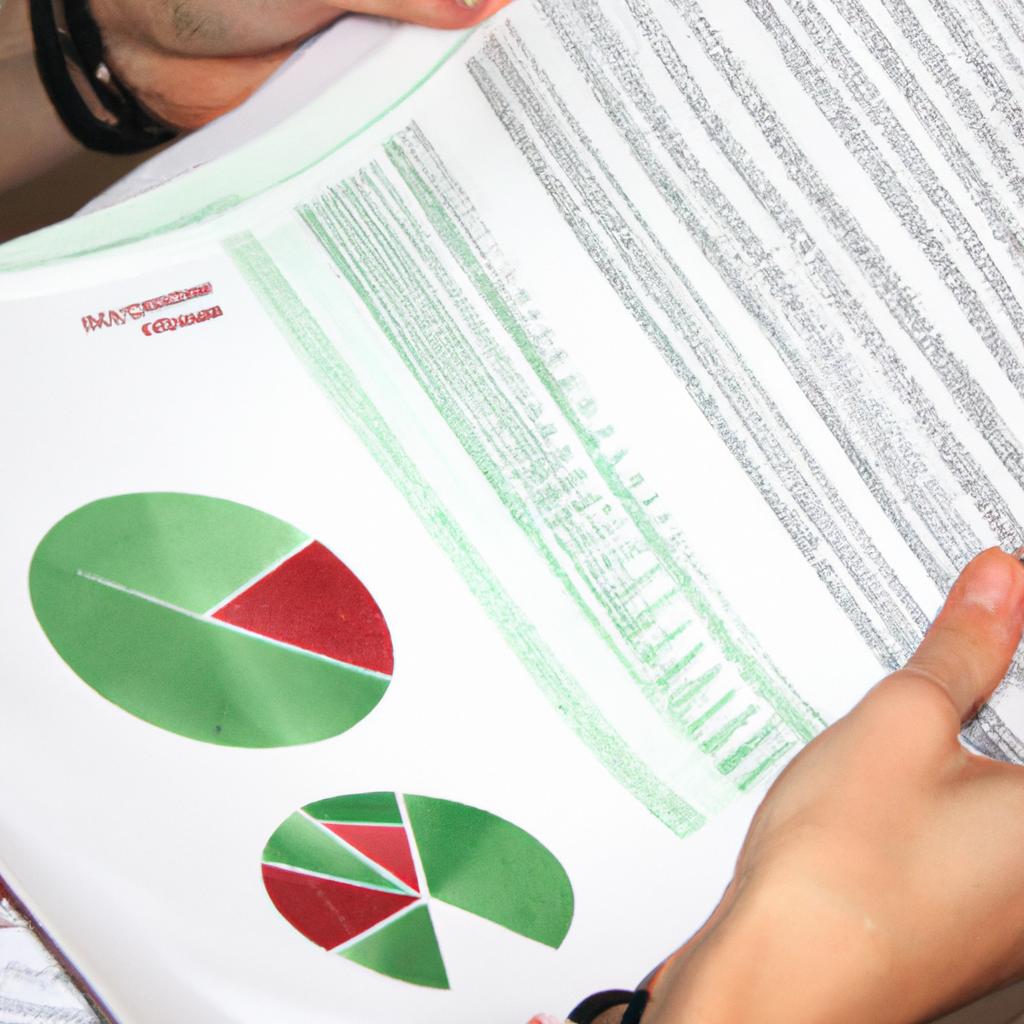Bond Convexity: A Key Factor in Investing in Bonds

Bond convexity is a critical concept in the field of bond investing, as it plays a significant role in determining the price sensitivity of bonds to changes in interest rates. It refers to the relationship between a bond’s price and its yield-to-maturity, taking into account the shape of the bond’s cash flow stream over time. Understanding bond convexity is essential for investors seeking to optimize their investment strategies by effectively managing risk and maximizing returns.
To illustrate the importance of bond convexity, let us consider an example: Imagine an investor who holds two bonds with identical maturities and coupon rates but different levels of convexity. Bond A has high positive convexity, while Bond B exhibits negative convexity. Now suppose there is a sudden decrease in interest rates. The price of both bonds would increase due to their inverse relationship with yields; however, Bond A would experience a greater percentage increase compared to Bond B because of its positive convexity. Conversely, if interest rates were to rise unexpectedly, both bonds’ prices would decline, but Bond B would suffer more substantial losses than Bond A due to its negative convexity. This case study highlights how understanding and utilizing bond convexity can significantly impact investment outcomes.
What is Bond Convexity?
What is Bond Convexity?
Bond convexity is an important concept in the field of finance, particularly when it comes to investing in bonds. It refers to the relationship between a bond’s price and its yield, taking into account the shape of the bond’s cash flow pattern over time. Understanding bond convexity can provide investors with valuable insights into potential risks and returns associated with their investment portfolios.
To illustrate this concept, let’s consider an example. Imagine two bonds: Bond A and Bond B, both having similar characteristics such as maturity date and coupon rate. However, Bond A has higher convexity than Bond B. Now suppose interest rates decrease by 1%. Due to its higher convexity, Bond A will experience a larger increase in price compared to Bond B. This means that even though both bonds have similar durations, Bond A offers greater potential for capital appreciation.
When discussing bond convexity, there are several key points to keep in mind:
- Diversification: Investing in bonds with varying levels of convexity allows for diversification within a portfolio. By including bonds with different degrees of convexity, investors can potentially reduce risk while still maintaining attractive return opportunities.
- Risk management: Understanding how changes in interest rates affect bond prices through the lens of convexity can help investors manage their risk exposure effectively.
- Yield curve analysis: Analyzing the shape and slope of the yield curve provides insight into future movements in interest rates and helps determine which types of bonds may offer better risk-adjusted returns.
- Duration vs. Convexity: While duration measures sensitivity to changes in interest rates based on a linear approximation, convexity takes into account non-linear relationships between price and yield. Thus, considering both duration and convexity together provides a more comprehensive view of market dynamics.
Table showcasing examples:
| Duration (Years) | Convexity | |
|---|---|---|
| Bond A | 5 | 20 |
| Bond B | 5 | 10 |
In summary, bond convexity is an essential factor to consider when investing in bonds. It allows investors to understand how changes in interest rates can impact bond prices and helps assess the potential risks and rewards associated with different investments. By utilizing diversification strategies, managing risk effectively, analyzing yield curves, and considering both duration and convexity, investors can make more informed decisions about their fixed-income portfolios.
Transitioning into the next section: Understanding the importance of bond convexity provides a foundation for successful investment strategies.
The Importance of Understanding Bond Convexity
Bond Convexity: A Key Factor in Investing in Bonds
In the previous section, we explored what bond convexity is and how it affects bond investments. Now, let’s delve deeper into the importance of understanding bond convexity and its implications for investors.
To illustrate the significance of bond convexity, consider a hypothetical scenario where an investor holds two bonds with similar coupon rates and maturities but different convexities. Bond A has positive convexity, while Bond B has negative convexity. As interest rates change, these bonds will exhibit distinct price movements due to their differing convexities.
Understanding bond convexity becomes crucial for investors because it provides insights into potential changes in bond prices when interest rates fluctuate. Here are some key reasons why grasping this concept is important:
- Risk management: By analyzing the convexity of a bond or a portfolio of bonds, investors can better assess their exposure to interest rate risk. Positive convexity acts as a cushion against falling prices when rates rise, offering some protection to investors’ capital.
- Yield enhancement opportunities: Investors can strategically select bonds with higher positive convexities to potentially enhance yields during periods of declining interest rates.
- Portfolio optimization: Incorporating bonds with varying levels of convexity can help diversify risk within a fixed income portfolio.
- Trading strategies: Traders can utilize knowledge of bond convexities to develop trading strategies that take advantage of anticipated changes in prices resulting from interest rate fluctuations.
To further understand the impact of bond convexity on investment decisions, let’s look at a comparison between two hypothetical bonds – Bond X and Bond Y:
| Bond X | Bond Y | |
|---|---|---|
| Coupon Rate | 5% | 5% |
| Maturity | 10 years | 10 years |
| Convexity | Positive | Negative |
Suppose there is an unexpected decrease in interest rates by 1%. Due to its positive convexity, Bond X would experience a larger price increase compared to Bond Y with negative convexity. This exemplifies how bond convexity can significantly affect investment returns and underscores the importance of understanding this concept.
In summary, comprehending bond convexity is crucial for investors seeking to make informed decisions when investing in bonds. It enables better risk management, presents yield enhancement opportunities, aids portfolio optimization, and facilitates the development of effective trading strategies.
Factors Affecting Bond Convexity
Understanding Bond Convexity is crucial for investors in the bond market. It helps them assess the potential price volatility of their bond investments, which can have a significant impact on overall portfolio performance. In this section, we will delve deeper into the factors that affect bond convexity.
To illustrate the importance of bond convexity, let’s consider an example. Suppose Investor A and Investor B both own bonds with similar maturities and coupon rates. However, Investor A holds a bond with higher convexity than Investor B’s bond. If interest rates were to decrease by 1%, Investor A’s bond would experience a greater increase in price compared to Investor B’s bond due to its higher convexity. This highlights how understanding and taking advantage of bond convexity can lead to favorable investment outcomes.
Several key factors influence the level of convexity present in a particular bond:
- Coupon rate: Bonds with lower coupon rates generally exhibit higher levels of convexity since they are more sensitive to changes in interest rates.
- Time to maturity: Longer-dated bonds tend to have higher convexity as their cash flows are spread out over a longer period, making them more responsive to interest rate fluctuations.
- Yield-to-maturity: Lower yields correspond to higher levels of convexity because when interest rates decline, the price appreciation becomes more pronounced at lower yield levels.
- Callability: Callable bonds typically have lower levels of convexity since their future cash flows may be impacted if the issuer decides to call back or redeem the bonds before maturity.
Let us now summarize these factors affecting bond convexity using a table:
| Factor | Effect on Convexity |
|---|---|
| Coupon Rate | Inverse relationship; lower coupon = higher convexity |
| Time to Maturity | Direct relationship; longer maturity = higher convexity |
| Yield-to-Maturity | Inverse relationship; lower yield = higher convexity |
| Callability | Inverse relationship; callable = lower convexity |
Understanding these factors is essential for investors to make informed decisions based on their risk tolerance and investment objectives. By considering the various components that contribute to bond convexity, investors can strategically position themselves in the market to maximize potential returns while managing risks effectively.
Moving forward, let us explore how bond convexity can be calculated and utilized as a valuable tool in bond investing.
Calculating Bond Convexity
In the previous section, we explored the concept of bond convexity and its importance in bond investing. Now, let’s delve deeper into the factors that can affect a bond’s convexity.
One key factor is the coupon rate of the bond. Bonds with higher coupon rates tend to have lower convexity, while those with lower coupon rates generally exhibit higher convexity. This is because higher-coupon bonds make more frequent interest payments, reducing their sensitivity to changes in interest rates over time.
Another factor influencing bond convexity is maturity. Generally, longer-maturity bonds have higher convexity compared to shorter-maturity ones. This means that as interest rates change, the price of longer-term bonds will fluctuate more significantly than that of shorter-term bonds.
Credit quality also plays a role in determining a bond’s convexity. Lower-rated or riskier bonds typically have higher convexity due to their greater vulnerability to changes in market conditions and investor sentiment.
Finally, call features can impact a bond’s convexity. Callable bonds allow issuers to redeem them before maturity if certain conditions are met. The presence of call options decreases a bond’s potential for future capital appreciation and therefore reduces its overall convexity.
To illustrate these factors further, consider an example: Company XYZ issues two 10-year corporate bonds with different coupon rates – one with a 5% coupon and another with an 8% coupon. As interest rates decrease by 1%, the price increase for the 5% coupon bond will be larger than that of the 8% coupon bond due to differences in their respective levels of convexity.
Understanding how these factors influence bond convexity is crucial for investors when making informed decisions about portfolio allocation and risk management strategies.
Now that we have examined the factors affecting bond convexity, let us explore how this concept influences investment returns in our next section on “How Bond Convexity Influences Investment Returns.”
How Bond Convexity Influences Investment Returns
Bond Convexity: A Key Factor in Investing in Bonds
Calculating Bond Convexity has provided us with a quantitative measure of the sensitivity of bond prices to changes in interest rates. Now, let’s delve into how Bond Convexity influences investment returns and why it is essential for successful bond investing.
Imagine an investor who holds two bonds with identical durations but different convexities. The first bond has positive convexity, while the second bond has negative convexity. Suppose interest rates decrease by 1%. Due to its positive convexity, the price of the first bond will increase more than expected, resulting in higher total returns for the investor. On the other hand, due to its negative convexity, the price of the second bond will increase less than anticipated, leading to lower total returns for the investor.
Understanding these implications highlights the significance of considering Bond Convexity when constructing a fixed income portfolio. Here are four key reasons why incorporating Bond Convexity analysis can enhance investment decision-making:
- Risk mitigation: By diversifying holdings across bonds with varying levels of convexity, investors can reduce overall portfolio risk. This strategy helps protect against unexpected changes in interest rates.
- Enhanced return potential: Positive convexity allows investors to capture additional gains during periods of falling interest rates.
- Capital preservation: Bonds with high positive convexity tend to be less volatile and offer better protection against capital erosion.
- Yield enhancement: Incorporating bonds with positive convexity may help boost yield without taking on excessive risks.
To further illustrate this concept, consider Table 1 below which compares hypothetical scenarios using two bonds – one with positive convexity (Bond X) and another with negative convexity (Bond Y). It demonstrates how their respective prices respond differently to various changes in interest rates:
| Interest Rate Change | Bond X Price (%) | Bond Y Price (%) |
|---|---|---|
| -2% | 112.5 | 95 |
| -1% | 105 | 97 |
| +1% | 96 | 103 |
| +2% | 89.25 | 107 |
From the table, we can observe that Bond X’s price increases more than Bond Y when interest rates decrease and decreases less when interest rates increase. This behavior is a result of their differing convexities.
In summary, understanding how Bond Convexity influences investment returns is crucial for bond investors seeking to maximize their gains while managing risk effectively.
Strategies for Utilizing Bond Convexity
Section H2: Strategies for Utilizing Bond Convexity
Understanding the concept of bond convexity is crucial when it comes to making informed investment decisions. In this section, we will explore various strategies that investors can employ to effectively utilize bond convexity in their portfolios.
One strategy commonly used by investors is duration management. Duration measures the sensitivity of a bond’s price to changes in interest rates. By actively managing the duration of a bond portfolio, investors can take advantage of convexity and potentially enhance returns. For example, consider a hypothetical scenario where an investor expects interest rates to decrease significantly over the next year. They may choose to increase the duration of their portfolio by purchasing longer-term bonds with higher convexity. This would allow them to benefit more from falling interest rates, as the increased convexity amplifies the positive impact on bond prices.
Another approach is yield curve positioning. The yield curve represents the relationship between yields and maturities of bonds within a particular market. Investors who anticipate changes in the shape or slope of the yield curve can adjust their positions accordingly to capitalize on potential gains resulting from bond convexity. For instance, if an investor predicts that short-term interest rates will rise faster than long-term rates, they might opt for shorter-maturity bonds with lower convexity to minimize potential losses.
Furthermore, active trading strategies such as riding the convexity wave can be employed by experienced investors seeking short-term opportunities. When interest rates experience sudden shifts or volatility, certain bonds exhibit significant price movements due to their specific characteristics and embedded options. Skilled traders can identify these opportunities and execute trades strategically based on anticipated changes in both interest rates and convexity.
To summarize these strategies:
- Duration management: Adjusting portfolio duration to take advantage of increasing or decreasing convexity.
- Yield curve positioning: Capitalizing on anticipated changes in the shape or slope of the yield curve.
- Active trading: Exploiting short-term opportunities arising from sudden shifts or volatility in interest rates and convexity.
By employing these strategies, investors can effectively utilize bond convexity as a key factor in their investment decision-making process, potentially enhancing returns and managing risk more efficiently.
| Strategies for Utilizing Bond Convexity |
|---|
| – Duration management |
| – Yield curve positioning |
| – Active trading |
In conclusion, understanding and utilizing bond convexity is essential for investors seeking to optimize their bond portfolios. By incorporating duration management, yield curve positioning, and active trading strategies, investors can enhance their potential returns by taking advantage of the unique characteristics that convexity offers. It is important to note that each strategy carries its own risks and requires thorough analysis before implementation.






